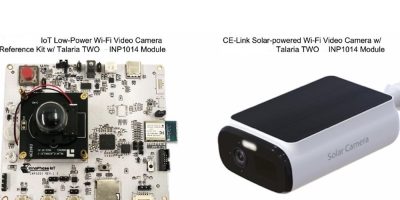Battery-operated video camera systems add AI for cloud IoT devices
InnoPhase IoT adds AI and solar panel augmentation to battery-operated video camera system via the Talaria TWO ULP (ultra low power) Wi-fi-optimised reference kit for cloud-connected IP video IoT devices.
In addition to applications such as battery-operated video cameras, smart video doorbells, wearables, smart appliances, home security cameras and in-vehicle dashboard monitoring devices, OEMs and ODMs are introducing new categories of video devices with designs that use solar technology and AI, said InnoPhase IoT.
Based on the Talaria TWO ULP Wi-Fi and Bluetooth Low Energy (BLE) platform, the reference kit consists of dual stack, power optimised software combined with an advanced digital polar radio design to address the challenges involved with yesterday’s power-hungry processing of video IoT designs with a multi-protocol, cloud connected camera system, said the company.
The InnoPhase IoT Talaria TWO wireless platform for video supports up to 2K camera resolution and has an integrated microcontroller which enables off-loading of TCP-IP networking and cloud connectivity stack when ISP (image signal processing) is powered down. An always on, always connected enables low latency and mitigates image loss issues and the low power Wi-Fi at BLE power levels enables a two to four times improvement in battery life.
Until now, untethered wireless cloud connectivity and a long battery life were major design barriers for video IoT. Approximately 10 per cent of video cameras are currently battery-operated primarily because of battery life limitations, reported InnoPhase IoT. Moving to a wireless format wasn’t possible since ubiquitous Wi-Fi is inherently power hungry, rapidly draining video camera’s batteries. The possibility of adding even more features such as AI would mean an even shorter battery life.
The new InnoPhase IoT video reference kit address all of these challenges and provides 40 per cent lower power consumption and a battery life in excess of one year. The company also said it offers device developers a variety of market ready solutions from OEMs and ODMs.
“Using InnoPhase IoT Talaria TWO and an Ingenic T31 integrated reference design, we have been able to build an AI-enabled smart video camera with battery life two to three times longer than today’s solutions. We’re also achieving multi-year battery life when augmented with a solar panel”, said Larry Yang, product manager of smart product line at CE-Link, a wireless video camera OEM. The reference design can be customised, enabling customers to quickly bring branded wireless camera systems to market, he added.
According to Jason Lim, CEO at Kenxen, Taiwan, a smart video camera ODM, the Talaria TWO Wi-Fi / BLE module enables low power, direct-to-cloud connectivity for battery operated cameras. “This allows us to offer quick time to market video products for our end customers,” he added.
InnoPhase IoT president and COO, Wiren Perera, said: “InnoPhase IoT’s Talaria TWO untethers cameras from all wired power and network connections, resulting in more accurate data for cloud processing. It supports the addition of enhanced features such as artificial intelligence and unleashes design creativity only possible with the low-power, long battery-life model.”
The reference kits are currently available for evaluation. Each includes hardware and software integration with an image signal processor, cloud connectivity software and access to ODMs.




